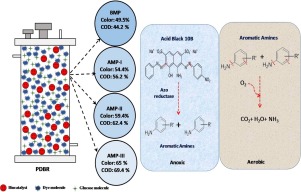当前位置:
X-MOL 学术
›
J. Hazard. Mater.
›
论文详情
Our official English website, www.x-mol.net, welcomes your
feedback! (Note: you will need to create a separate account there.)
Metabolic phasing of anoxic-PDBR for high rate treatment of azo dye wastewater
Journal of Hazardous Materials ( IF 12.2 ) Pub Date : 2017-08-30 , DOI: 10.1016/j.jhazmat.2017.08.065 C. Nagendranatha Reddy , A. Naresh Kumar , S. Venkata Mohan
Journal of Hazardous Materials ( IF 12.2 ) Pub Date : 2017-08-30 , DOI: 10.1016/j.jhazmat.2017.08.065 C. Nagendranatha Reddy , A. Naresh Kumar , S. Venkata Mohan

|
The treatment of azo dye wastewater was studied in a periodic discontinuous batch reactor (PDBR) at higher loading condition (1250 mg/l) under anoxic microenvironment. The biosystem performance was assessed under different aerobic/total time ratio during the cycle operation [before multiphasing (BMP; Control), 0.014; after multiphasing (AMP): AMPI, 0.84; AMPII, 0.73; AMPIII, 0.65]. Induction of air in anoxically operated PDBR facilitated the simultaneous oxidation and reduction microenvironments and thus resulted in higher dye removal in AMPIII operation (65%) followed by AMPII (59.4%) and AMPI (54.4%) than the corresponding control operation (BMP: 49.4%). Relatively higher azo reductase enzyme activity was documented with AMP operation thus correlating well with azo dye decolorization. UV–Visible spectra (200–800 nm) resulted significant transformational changes of azo dye peaks (618 nm) before and after multiphase operations. Cyclic voltammograms profiles depicted significant drop in redox catalytic currents during AMPIII operation and also supports the consumption of reducing equivalents towards the dye removal. Derivatives of voltammograms depicted the involvement of various redox mediators viz., cytochrome-C, quinones, Fumarate/Succinate, Fe(CN)63−/Fe(CN)64−, and flavoproteins. Flexibility in phasing the multiple microenvironments in single bioreactor provides new insights in embodying the required capabilities to treat the recalcitrant azo dye wastewater especially at higher dye load operations
中文翻译:

缺氧-PDBR的生物相法高速率处理偶氮染料废水
在缺氧微环境下,在较高负荷条件(1250 mg / l)下的周期性间歇间歇式反应器(PDBR)中研究了偶氮染料废水的处理。在循环操作过程中,在不同的有氧/总时间比率下评估生物系统性能[多相之前(BMP;对照),0.014;多相(AMP)后:AMPI,0.84;AMPII,0.73;AMPIII,0.65]。在缺氧操作的PDBR中引入空气有助于同时氧化和还原微环境,因此与相应的对照操作相比,AMPIII操作(65%),AMPII(59.4%)和AMPI(54.4%)导致更高的染料去除率(BMP:49.4) %)。AMP操作记录了较高的偶氮还原酶活性,因此与偶氮染料脱色密切相关。紫外可见光谱(200–800 nm)在多相操作之前和之后均导致偶氮染料峰(618 nm)发生明显的变化。循环伏安图谱描述了在AMPIII操作期间氧化还原催化电流的显着下降,并且还支持消耗还原当量以去除染料。伏安图的衍生物描述了各种氧化还原介体的参与,即细胞色素-C,醌,富马酸酯/琥珀酸酯,Fe(CN)6 3− / Fe(CN)6 4−和黄素蛋白。在单个生物反应器中定相多个微环境的灵活性,为体现所需的处理难处理的偶氮染料废水的能力提供了新见解,特别是在较高的染料负载操作下
更新日期:2017-08-31
中文翻译:

缺氧-PDBR的生物相法高速率处理偶氮染料废水
在缺氧微环境下,在较高负荷条件(1250 mg / l)下的周期性间歇间歇式反应器(PDBR)中研究了偶氮染料废水的处理。在循环操作过程中,在不同的有氧/总时间比率下评估生物系统性能[多相之前(BMP;对照),0.014;多相(AMP)后:AMPI,0.84;AMPII,0.73;AMPIII,0.65]。在缺氧操作的PDBR中引入空气有助于同时氧化和还原微环境,因此与相应的对照操作相比,AMPIII操作(65%),AMPII(59.4%)和AMPI(54.4%)导致更高的染料去除率(BMP:49.4) %)。AMP操作记录了较高的偶氮还原酶活性,因此与偶氮染料脱色密切相关。紫外可见光谱(200–800 nm)在多相操作之前和之后均导致偶氮染料峰(618 nm)发生明显的变化。循环伏安图谱描述了在AMPIII操作期间氧化还原催化电流的显着下降,并且还支持消耗还原当量以去除染料。伏安图的衍生物描述了各种氧化还原介体的参与,即细胞色素-C,醌,富马酸酯/琥珀酸酯,Fe(CN)6 3− / Fe(CN)6 4−和黄素蛋白。在单个生物反应器中定相多个微环境的灵活性,为体现所需的处理难处理的偶氮染料废水的能力提供了新见解,特别是在较高的染料负载操作下










































 京公网安备 11010802027423号
京公网安备 11010802027423号